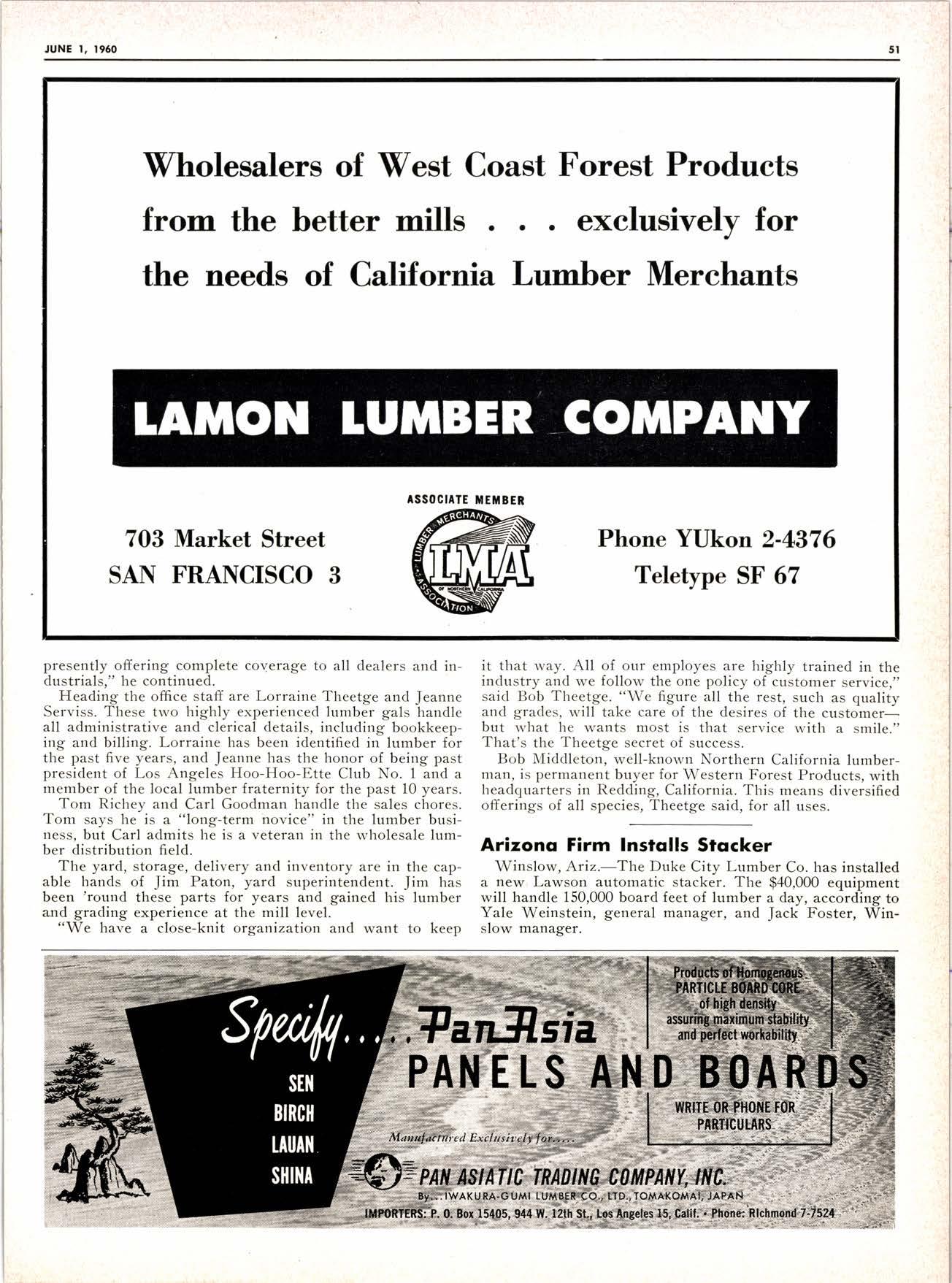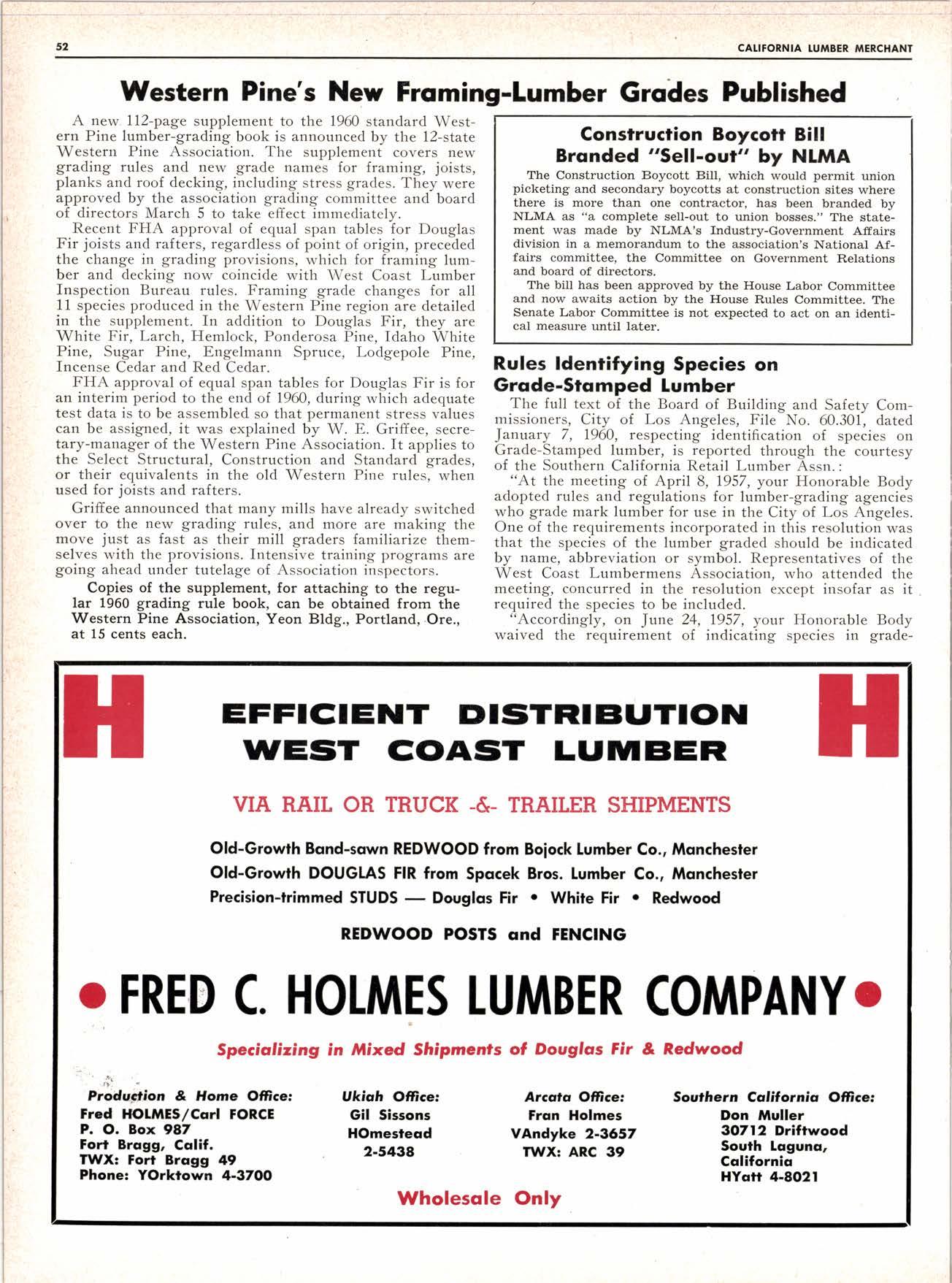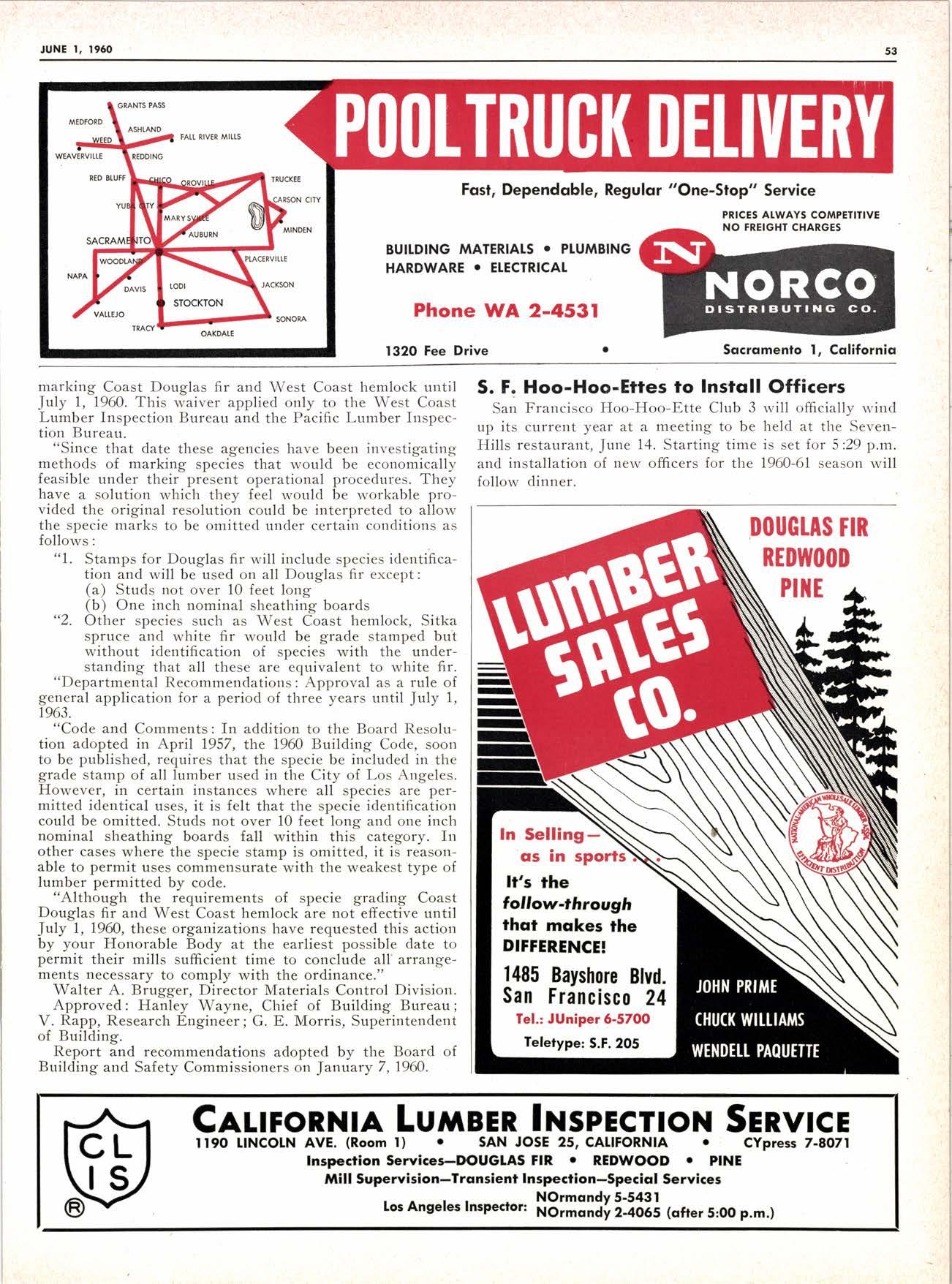
5 minute read
Wholesalers of West Coast Forest Products from the better mills
presently offering complete coverage to all dealers and industrials," he continued.
Heading the office staff are Lorraine Theetge and Jeanne Serviss. These two highly experienced lumber gals handle all administrative and clerical details, including bookkeeping and billing. Lorraine has been identified in lumber for the past five years, and Jeanne has the honor of being past president of Los Angeles Hoo-Hoo-Ette Club No. 1 and a member of the local lumber fraternity for the past 10 years.
Tom Richey and Carl Goodman handle the sales chores. Tom says he is a "long-term novice" in the lumber business, but Carl admits he is a veteran in the wholesale lumber distribution field.
The yard, storage, delivery and inventory are in the capable hands of Jim Paton, yard superintendent. Jim has been 'round these parts for years and gained his lumber and grading experience at the mill level.
"'We have a close-knit organization and want to keep it that way. All of our employes are highly trained in the industry and we follow the one policy of customer service," said Bob Theetge. "We figure all the rest, such as quality and grades, wilf take carebf the desires of the cust&nei but what he wants most is that service with a smile." That's the Theetge secret of success.
Bob Middleton, well-known Northern California lumberman, is permanent buyer for Western Forest Products, with headquarters in Redding, California. This means diversified offerings of all species, Theetge said, for all uses.
Arizonq Firm Instqlls Stqcker
Winslow, Ariz.-The Duke City Lumber Co. has installed a new Lawson automatic stacker. The $40,000 equipment will handle 150,000 board feet of lumber a day, according to Yale Weinstein, general manager, and Jack Foster, Winslow manager.
Western Pine's New Froming-Lumber Grodes Published
A new. Il2-page supplement to the 1960 standard Western Pine lumber-grading book is announced by the I2-state Western Pine Association. The supplement covers new grading rules and new grade names for framing, joists, planks and roof decking, including stress grades. They were approved by the association grading committee and board of directors March 5 to take effect immediately.
Recent FHA approval of equal span tables for Douglas Fir joists and rafters, regardless of point of origin, preceded the change in grading provisions, which for framing lumber and decking now coincide with West Coast Lumber Inspection Bureau rules. Framing grade changes for all 11 species produced in the Western Pine region are detailed in the supplement. In addition to Douglas Fir, they are White Fir, Larch, Hemlock, Ponderosa Pine, Idaho White Pine, Sugar Pine, Engelmann Spruce, Lodgepole Pine, Incense Cedar and Red Cedar.
FHA approval of equal span tables for Douglas Fir is for an interim period to the end of 1960, during which adequate test data is to be assembled so that permanent stress values can be assigned, it was explained by W. E. Griffee, secretary-manager of the \Mestern Pine Association. It applies to the Select Structural, Construction and Standard grades, or their equivalents in the old Western Pine rules, when used for joists and rafters.
Griffee announced that many mills have already switched over to the new grading rules, and more are making the move just as fast as their mill graders familiarize themselves with the provisions. Intensive training programs are going ahead under tutelage of Association inspectors.
Copies of the supplement, for attaching to the regu- lar 1960 grading rule book, can be obtained from the Western Pine Association, Yeon Bldg., Portland,.Ore., at 15 cents each.
Gonstruction Boycoff Bill
Brqnded "Sell-ou|" by NlJt[A
The Construction Boycott Bill, which would permit union picketing and secondary boycotts at construction sites where there is more than one contractor, has been branded by NLMA as "a complete sell-out to union bosses." The statement was made by NLMA's Industry-Government Affairs division in a memorandum to the association's National Affairs committee, the Committee on Government Relations and board of directors.
The bill has been approved by the House Labor Committee and now awaits action by the llouse Rules Committee. The Senate Labor Committee is not expeeted to act on an identical measure until later.
Rules ldenrifying Species on Grode-Stomped Lumber
The full text of the Board of Building and Safety Commissioners, City of Los Angeles, File No. 60.301, dated January 7, 1960, respecting identification of species on Grade-Stamped lumber, is reported through the courtesy of the Southern California Retail Lumber Assn.:
"At the meeting of April 8, 1957, your llonorable Body adopted rules and regulations for lumber-grading agencies who grade mark lumber for use in the City of Los Angeles. One of the requirements incorporated in this resolution was that the species of the lumber graded should be indicated by name, abbreviation or symbol. Representatives of the West Coast Lumbermens Association, who attended the meeting, concurred in the resolution except insofar as it required the species to be included.
"Accordingly, on June 24, 1957, your Honorable Body waived the requirement of indicating species in grade- marking Coast Douglas fir and West Coast hemlock until July 1, i960. This waiver applied only to the West Coast Lumber Inspection Bureau and the Pacific Lumber Inspection Bureau.

"Since that date these agencies have been investigating methods of marking species that would be economically feasible under their present operational procedures. They have a solution which they feel would be workable provided the original resolution could be interpreted to allow the specie marks to be omitted under certain conditions as follows:
"I. Stamps for Douglas fir will include species identification and will be used on all Douglas fir except:
(a) Studs not over 10 feet long
(b) One inch nominal sheathing boards
"2. Other species such as West Coast hemlock, Sitka spruce and white fir would be grade stamped but without identification of species with the understanding that all these are equivalent to white fir.
"Departmental Recommendations: Approval as a rule of general application for a period of three years until July 1, 1963.
"Code and Comments: In addition to the Board Resolution adopted in April 1957, the 1960 Building Code, soon to be published, requires that the specie be included in the grade stamp of all lumber used in the City of Los Angeles. However, in certain instances where all species are permitted identical uses, it is felt that the specie identification could be omitted. Studs not over 10 feet long and one inch nominal sheathing boards fall within this category. In other cases where the specie stamp is omitted, it is reasonable to permit uses commensurate with the weakest type of lumber permitted by code.

"Although the requirements of specie grading Coast Douglas fir and West Coast hemlock are not effective until July 1, 1960, these organizations have requested this action by your Honorable Body at the earliest possible date to permit their mills sufficient time to conclude all' arrangements necessary to comply with the ordinance."
Walter A. Brugger, Director Materials Control Division.
Approved: Hanley Wayne, Chief of Building Bureau ; V. Rapp, Research Engineer; G. E. Morris, Superintendent of Building.
Report and recommendations adopted by the Board of Building and Safety Commissioners on January 7,1960.
5. F. Hoo-Hoo-Ettes fo Instclll Officers
San Francisco Hoo-Hoo-Ette Club 3 will officially wind up its current year at a meetirlg to be held at the SevenHills restaurant, June 14. Starting time is set for 5:29 p.m. and installation of new officers for the 1960-61 season will follow dinner.










